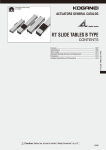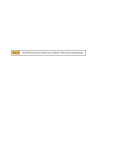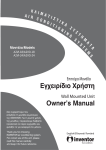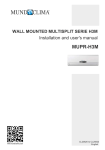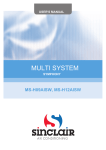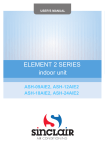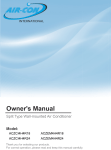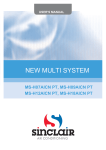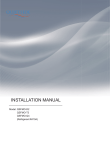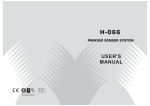Download Installation Manual
Transcript
INSTALLATION MANUAL Model: QS09-VJ115 QS12-VJ115 QS09-VP115 QS12-VP115 (Refrigerant R410A) Service Manual Part Ⅱ : Installation and Maintenance 7. Notes for Installation and Maintenance Safety Precautions: Important! Please read the safety precautions carefully before installation and maintenance. The following contents are very important for installation and maintenance. Please follow the instructions below. ●The installation or maintenance must accord with the instructions. ●Comply with all national electrical codes and local electrical codes. ●Pay attention to the warnings and cautions in this manual. ●All installation and maintenance shall be performed by distributor or qualified person. ●All electric work must be performed by a licensed technician according to local regulations and the instructions given in this manual. ●Be caution during installation and maintenance. Prohibit incorrect operation to prevent electric shock, casualty and other accidents. Warnings Electrical Safety Precautions: 1. Cut off the power supply of air conditioner before checking and maintenance. 2. The air condition must apply specialized circuit and prohibit share the same circuit with other appliances. 3. The air conditioner should be installed in suitable location and ensure the power plug is touchable. 4. Make sure each wiring terminal is connected firmly during installation and maintenance. 5. Have the unit adequately grounded. The grounding wire can’t be used for other purposes. 6. Must apply protective accessories such as protective boards, cable-cross loop and wire clip. 7. The live wire, neutral wire and grounding wire of power supply must be corresponding to the live wire, neutral wire and grounding wire of the air conditioner. 8. The power cord and power connection wires can’t be pressed by hard objects. 9. If power cord or connection wire is broken, it must be replaced by a qualified person. 22 10. If the power cord or connection wire is not long enough, please get the specialized power cord or connection wire from the manufacture or distributor. Prohibit prolong the wire by yourself. 11. For the air conditioner without plug, an air switch must be installed in the circuit. The air switch should be all-pole parting and the contact parting distance should be more than 3mm. 12. Make sure all wires and pipes are connected properly and the valves are opened before energizing. 13. Check if there is electric leakage on the unit body. If yes, please eliminate the electric leakage. 14. Replace the fuse with a new one of the same specification if it is burnt down; don’t replace it with a cooper wire or conducting wire. 15. If the unit is to be installed in a humid place, the circuit breaker must be installed. Installation Safety Precautions: 1. Select the installation location according to the requirement of this manual.(See the requirements in installation part) 2. Handle unit transportation with care; the unit should not be carried by only one person if it is more than 44lb. 3. When installing the indoor unit and outdoor unit, a sufficient fixing bolt must be installed; make sure the installation support is firm. 4. Ware safety belt if the height of working is above 6.6ft. 5. Use equipped components or appointed components during installation. 6. Make sure no foreign objects are left in the unit after finishing installation. Improper installation may lead to fire hazard, explosion, electric shock or injury. Technical Information Service Manual Main Tools for Installation and Maintenance 1. Level meter, measuring tape 2. Screw driver 3. Impact drill, drill head, electric drill 4. Electroprobe 5. Universal meter 6. Torque wrench, open-end wrench, inner hexagon spanner 7. Electronic leakage detector 8. Vacuum pump 9. Pressure meter 10. Pipe pliers, pipe cutter 11. Pipe expander, pipe bender 12. Soldering appliance, refrigerant container Installation and Maintenance 23 Service Manual 8. Installation 8.1 Installation Dimension Diagram At least 0.5ft. Space to the ceiling Installation dimension diagram Space to the wall Space to the wall At least 0.5ft. At least 8.2ft. ft. 10 st lea At ac At et ot lea st e ac Sp 24 he to o et ac Sp ll n tio uc tr bs o the st a t le A wa 1ft At least 1.6ft. Sp Space to the obstruction Sp ac et ot he ob str uc tio Space to the floor n At least 0.5ft. . 1ft . the on t. .6f t6 cti Drainage pipe u str ob At Sp s lea At ac et lea st ot he 1.6 ft. ob str uc tio n Installation and Maintenance Service Manual Installation procedures Start installation Preparation before installation Read the requirements for electric connection select installation location Select indoor unit installation location Prepare tools Select outdoor unit installation location Install the support of outdoor unit (select it according to the actual situation) Install wall-mounting frame, drill wall holes Connect pipes of indoor unit and drainage pipe Fix outdoor unit Connect wires of indoor unit Install drainage joint of outdoor unit (only for cooling and heating unit) Bind up pipes and hang the indoor unit Make the bound pipes pass through the wall hole and then connect outdoor unit Connect pipes of outdoor unit Connect wires of outdoor unit Neaten the pipes Vacuum pumping and leakage detection Check after installation and test operation Finish installation Note: this flow is only for reference; please find the more detailed installation steps in this section. Installation and Maintenance 25 Service Manual 8.2 Installation Parts-checking No. 1 2 Name Indoor unit Outdoor unit No. 8 9 3 Connection pipe 10 4 Drainage pipe Wall-mounting frame Connecting cable(power cord) Wall pipe 11 5 6 7 12 13 Name Sealing gum Wrapping tape Support of outdoor unit Fixing screw Drainage plug(cooling and heating unit) Owner’s manual, remote controller Note: 1.Please contact the local agent for installation. 2.Don't use unqualified power cord. 8.3 Selection of Installation Location 1. Basic Requirement: Installing the unit in the following places may cause malfunction. If it is unavoidable, please consult the local dealer: (1) The place with strong heat sources, vapors, flammable or explosive gas, or volatile objects spread in the air. (2) The place with high-frequency devices (such as welding machine, medical equipment). (3) The place near coast area. (4) The place with oil or fumes in the air. in the air. (5) The place with sulfureted gas. (6) Other places with special circumstances. 2. Indoor Unit: (1) There should be no obstruction near air inlet and air outlet. (2) Select a location where the condensation water can be dispersed easily and won't affect other people. (3) Select a location which is convenient to connect the outdoor unit and near the power socket. (4) Select a location which is out of reach for children. (5) The location should be able to withstand the weight of indoor unit and won't increase noise and vibration. (6) The height of indoor unit should be between 8ft. from the floor in order to provide sufficient space for maintenance. (7) Don't install the indoor unit right above the electric appliance. (8) The appliance shall not be installed in the laundry 3. Outdoor unit: 1.Select a location where the noise and outflow air emitted by the outdoor unit will not affect neighborhood. 2.The location should be well ventilated and dry, in which the outdoor unit won't be exposed directly to sunlight or strong wind. 3.The location should be able to withstand the weight of outdoor unit. 4.Make sure that the installation follows the requirement of installation dimension diagram. 5.Select a location which is out of reach for children and far away from animals or plants.If it is unavoidable, please add fence for safety purpose. 26 8.4 Requirements Forelectric Connection 1. Safety precaution (1) Must follow the electric safety regulations when installing the unit. (2) According to the local safety regulations, use qualified power supply circuit and air switch. (3) Make sure the power supply matches with the requirement of air conditioner. Unstable power supply or incorrect wiring may result in electric shock,fire hazard or malfunction. Please install proper power supply cables before using the air conditioner. (4) Properly connect the live wire, neutral wire and grounding wire of power socket. (5) Be sure to cut off the power supply before proceeding any work related to electricity and safety. (6) Do not put through the power before finishing installation. (7) For appliances with type Y attachment,the instructions shall contain the substance of thefollowing.If the supply cord is damaged,it must be replaced by the manufacturer,its service agent or similarly qualified persons in order to avoid a hazard. (8) The temperature of refrigerant circuit will be high, please keep the interconnection cable away from the copper tube. 2. Grounding requirement: (1) The air conditioner is first class electric appliance. It must be properly grounding with specialized grounding device by a professional. Please make sure it is always grounded effectively, otherwise it may cause electric shock. (2) The yellow-green wire in air conditioner is grounding wire, which can't be used for other purposes. (3) The grounding resistance should comply with national electric safety regulations. (4) The appliance must be positioned so that the plug is accessible (5) An all-pole disconnection switch having a contact separation of at least 3mm in all poles should be connected in fixed wiring. (6) Including an air switch with suitable capacity, please note the following table. Air switch should be included magnet buckle and heating buckle function, it can protect the circuitshort and overload. (Caution: please do not use the fuse only for protect the circuit) 8.5 Installation of Indoor Unit 1. Choosing Installation Iocation Recommend the installation location to the client and then confirm it with the client. 2. Install Wall-mounting Frame (1) Hang the wall-mounting frame on the wall; adjust it in horizontal position with the level meter and then point out the screw fixing holes on the wall. (2) Drill the screw fixing holes on the wall with impact drill (the specification of drill head should be the same as the plastic expansion particle) and then fill the plastic expansion particles in the holes. (3) Fix the wall-mounting frame on the wall with tapping screws (ST4.2X25TA) and then check if the frame is firmly installed by pulling the frame. If the plastic expansion particle is loose, please drill another fixing hole nearby. Installation and Maintenance Service Manual 3. Install Wall-mounting Frame (1) Choose the position of piping hole according to the direction of outlet pipe. The position of piping hole should be a little lower than the wall-mounted frame.(As show in Fig.1) Wall Left Ф55 mm Φ2.2 inch Wall Mark on the middle of it Space to the Space to the wall wall 1 5 0 m5ft. m above above Gradienter Right Fig.1 (Rear piping hole) Space to the Space to the wall wall 5ft. 150m m above above (Rear piping hole) Φ2.2mm inch Ф55 (2) Open a piping hole with the diameter of Φ55 on the selected outlet pipe position.In order to drain smoothly, slant the piping hole on the wall slightly downward to the outdoor side with the gradient of 5-10°.(As show in Fig.2) Indoor 5. Connect the Pipe of Indoor Unit (1) Aim the pipe joint at the corresponding bellmouth.(As show in Fig.5) (2) Pretightening the union nut with hand. (3) Adjust the torque force by referring to the following sheet. Place the open-end wrench on the pipe joint and place the torque wrench on the union nut. Tighten the union nut with torque wrench.(As show in Fig.6) (4) Wrap the indoor pipe and joint of connection pipe with insulating pipe, and then wrap it with tape.(As show in Fig.7) Open-end wrench Union nut Pipe joint Union nut Pipe Fig.5 Φ55 inch or Φ70 Φ2.2 Insulating pipe Fig.2 Hex nut diameter(inch) 1/4" 3/8” 1/2” 5/8” 3/4” (1) Pay attention to dust prevention and take relevant safety measures when opening the hole. (2) The plastic expansion particles are not provided and should be bought locally. 4. Outlet pipe (1) The pipe can be led out in the direction of right, rear right, left or rear left.(As show in Fig.3) (2) When selecting leading out the pipe from left or right, please cut off the corresponding hole on the bottom case.(As show in Fig.4) Tightening torque(N.m) 15~20 30~40 45~55 60~65 70~75 6. Install Drain Hose (1) Connect the drain hose to the outlet pipe of indoor unit.(As show in Fig.8) (2) Bind the joint with tape.(As show in Fig.9) Outlet pipe Left Right Rear left Rear right Fig.8 Outlet pipe Drain hose Drain hose Tape Fig.9 Note: Right Cut off the hole Fig.7 Refer to the following table for wrench moment of force: Note: Left Fig.6 Indoor pipe Outdoor 5-10° Fig.3 Pipe Torque wrench Fig.4 (1) Add insulating pipe in the indoor drain hose in order to prevent condensation. (2) The plastic expansion particles are not provided. (As show in Fig.10) Drain hose Insulating pipe Installation and Maintenance Fig.10 27 Service Manual 7. Connect Wire of Indoor Unit 8. Bind up Pipe (1) Open the panel, remove the screw on the wiring cover and then take down the cover.(As show in Fig.11) (1) Bind up the connection pipe, power cord and drain hose with the band.(As show in Fig.14) (2) Reserve a certain length of drain hose and power cord for installation when binding them. When binding to a certain degree, separate the indoor power and then separate the drain hose.(As show in Fig.15) (3) Bind them evenly. (4) The liquid pipe and gas pipe should be bound separately at the end. Panel Fig.11 Screw Wiring cover (2) Make the power connection wire go through the cable-cross hole at the back of indoor unit and then pull it out from the front side.(As show in Fig.12) Indoor unit Gas pipe Fig.14 Cable-cross hole Indoor and outdoor power cord Liquid pipe Band Drain hose Power connection wire Fig.12 (3) Remove the wire clip; connect the power connection wire to the wiring terminal; tighten the screw and then fix the power connection wire with wire clip.(As show in Fig.13) (4) Put wiring cover back and then tighten the screw. (5) Close the panel. N(1) 2 3 Fig.13 Note: (1) All wires of indoor unit and outdoor unit should be connected by a professional. (2) If the length of power connection wire is insufficient, please contact the supplier for a new one. Avoid extending the wire by yourself. (3) For the air conditioner with plug, the plug should be reachable after finishing installation. (4) For the air conditioner without plug, an air switch must be installed in the line. The air switch should be all-pole parting and the contact parting distance should be more than 3mm. Connection pipe Drain hose Indoor power cord Band Fig.15 Note: (1) The power cord and control wire can't be crossed or winding. (2) The drain hose should be bound at the bottom. 9. Hang the Indoor Unit (1) Put the bound pipes in the wall pipe and then make them pass through the wall hole. (2) Hang the indoor unit on the wall-mounting frame. (3) Stuff the gap between pipes and wall hole with sealing gum. (4) Fix the wall pipe. (As show in Fig.16) (5) Check if the indoor unit is installed firmly and closed to the wall.(As show in Fig.17) Indoor Wall pipe Outdoor Sealing gum Fig.17 Upper hook Fig.16 Lower hook of wall-mounting frame Note: Do not bend the drain hose too excessively in order to prevent blocking. 28 Installation and Maintenance Service Manual 8.6 Installation of Outdoor Unit Refer to the following table for wrench moment of force: 1. Fix the support of outdoor unit(select it according to the actual installation situation) Hex nut diameter(inch) 1/4" 3/8” 1/2” 5/8” 3/4” (1) Select installation location according to the house structure. (2) Fix the support of outdoor unit on the selected location with expansion screws. Note: (1) Take sufficient protective measures when installing the outdoor unit. (2) Make sure the support can withstand at least four times the unit weight. (3) The outdoor unit should be installed at least 3cm above the floor in order to install drain joint.(As show in Fig.18) (4) For the unit with cooling capacity of 2300W~5000W, 6 expansion screws are needed; for the unit with cooling capacity of 6000W~8000W, 8 expansion screws are needed; for the unit with cooling capacity of 10000W~16000W, 10 expansion screws are needed. Tightening torque(N.m) 15~20 30~40 45~55 60~65 70~75 5. Connect Outdoor Electric Wire (1)Remove the cable-crossing board 2 of right side plate for outdoor unit. (2)Remove the wire clamps, pass the power connection cord and power cord through the cable-crossing board 1 to connect the terminal. The wiring distribution must match with the electric diagram. (3)Fix the power connection cord and power cord with wire clamps tightly. (4)Check whether the wiring is fixed well. (5)Install the cable-crossing board 2. cable-crossing board 2 N Drain vent At least 3cm above the floor 3. Fix Outdoor Unit (1) Place the outdoor unit on the support. (2) Fix the foot holes of outdoor unit with bolts. (As show in Fig.20) Foot holes cable-crossing board 2 Foot holes Fig.21 Fig.20 4. Fix Outdoor Unit (1) Remove the screw on the cable-crossing board 2 of outdoor unit and then remove the cable-crossing board 2.(As show in Fig.21) (2) Remove the screw cap of valve and aim the pipe joint at the bellmouth of pipe.(As show in Fig.22) Liquid valve N 3 Fig.23 Note: (1) After tightening the screw, pull the power cord slightly to check if it is firm. (2) Never cut the power connection wire to prolong or shorten the distance. 6. Neaten the Pipes (1) The pipes should be placed along the wall, bent reasonably and hidden possibly. Min. semidiameter of bending the pipe is 10cm. (2) If the outdoor unit is higher than the wall hole, you must set a U-shaped curve in the pipe before pipe goes into the room, in order to prevent rain from getting into the room.(As show in Fig.24) The drain hos can't raise upwards Wall U-shaped curve Fig.25 Drain hose Note: Union nut Fig.22 (3) Pretightening the union nut with hand. (4) Tighten the union nut with torque wrench . Installation and Maintenance L Indoor unit connection Fig.24 Pipe joint gas pipe gas valve POWER cable-crossing board 1 Fig.18 Fig.19 2. Install Drain Joint(Only for cooling and heating unit) (1) Connect the outdoor drain joint into the hole on the chassis. (2) Connect the drain hose into the drain vent. (As show in Fig.19) Liquid pipe L 2 Chassis Outdoor drain joint Drain hose 2 3 (1) The through-wall height of drain hose shouldn't be higher than the outlet pipe hole of indoor unit.(As show in Fig.25) (2) Slant the drain hose slightly downwards. The drain hose can't be curved, raised and fluctuant, etc.(As show in Fig.26) 29 Service Manual (3) The water outlet can't be placed in water in order to drain smoothly.(As show in Fig.27) 8.8 Check after Installation and Test operation 1. Check after Installation Check according to the following requirement after finishing installation. The drain hose can't be fluctuant NO. The drain hose can't be fluctuant The water outlet can't be fluctuant 1 The water outlet can't be placed in water 2 Fig.27 Fig.26 4 8.7 Vacuum Pumping and Leak Detection 1. Use Vacuum Pump (1) Remove the valve caps on the liquid valve and gas valve and the nut of refrigerant charging vent. (2) Connect the charging hose of piezometer to the refrigerant charging vent of gas valve and then connect the other charging hose to the vacuum pump. (3) Open the piezometer completely and operate for 10-15min to check if the pressure of piezometer remains in -0.1MPa. (4) Close the vacuum pump and maintain this status for 1-2min to check if the pressure of piezometer remains in -0.1MPa. If the pressure decreases, there may be leakage. (5) Remove the piezometer, open the valve core of liquid valve and gas valve completely with inner hexagon spanner. (6) Tighten the screw caps of valves and refrigerant charging vent. (As show in Fig.28) Liquid valve Piezometer Lo Hi Gas valve Refrigerant charging vent Valve cap Nut of refrigerant Charging vent Vacuum pump Inner hexagon spanner Fig.28 3 Close Open Items to be checked Has the unit been installed firmly? Have you done the refrigerant leakage test? Is heat insulation of pipeline sufficient? Is water drained well? Is the voltage of power supply according to the 5 voltage marked on the nameplate? Is electric wiring and 6 pipeline installed correctly? Is the unit grounded 7 securely? Does the power cord 8 follow the specification? Is there any obstruction 9 in air inlet and air outlet? The dust and sundries caused 10 during installation are removed? The gas valve and liquid 11 valve of connection pipe are open completely? Possible malfunction The unit may drop, shake or emit noise. It may cause insufficient cooling (heating) capacity. It may cause condensation and water dripping. It may cause condensation and water dripping. It may cause malfunction or damage the parts. It may cause malfunction or damage the parts. It may cause electric leakage. It may cause malfunction or damage the parts. It may cause insufficient cooling (heating). It may cause malfunction or damaging the parts. It may cause insufficient cooling (heating) capacity. 2. Test operation (1) Preparation of test operation ● The client approves the air conditioner installation. ● Specify the important notes for air conditioner to the client. (2) Method of test operation ● Put through the power, press ON/OFF button on the remote controller to start operation. ● Press MODE button to select AUTO, COOL, DRY, FAN and HEAT to check whether the operation is normal or not. ● If the ambient temperature is lower than 16℃ , the air conditioner can’t start cooling. 2. Leakage detection (1) With leakage detector: Check if there is leakage with leakage detector. (2) With soap water: If leakage detector is not available, please use soap water for leakage detection. Apply soap water at the suspected position and keep the soap water for more than 3min. If there are air bubbles coming out of this position, there's a leakage. 30 Installation and Maintenance











